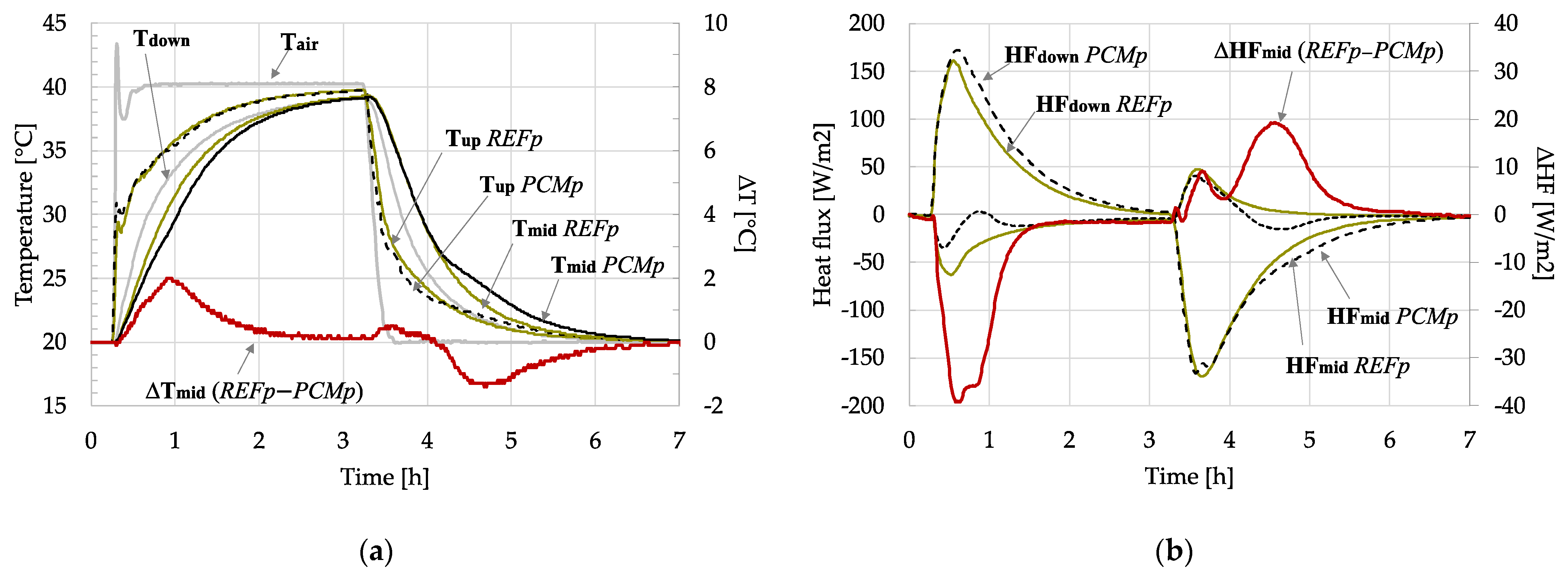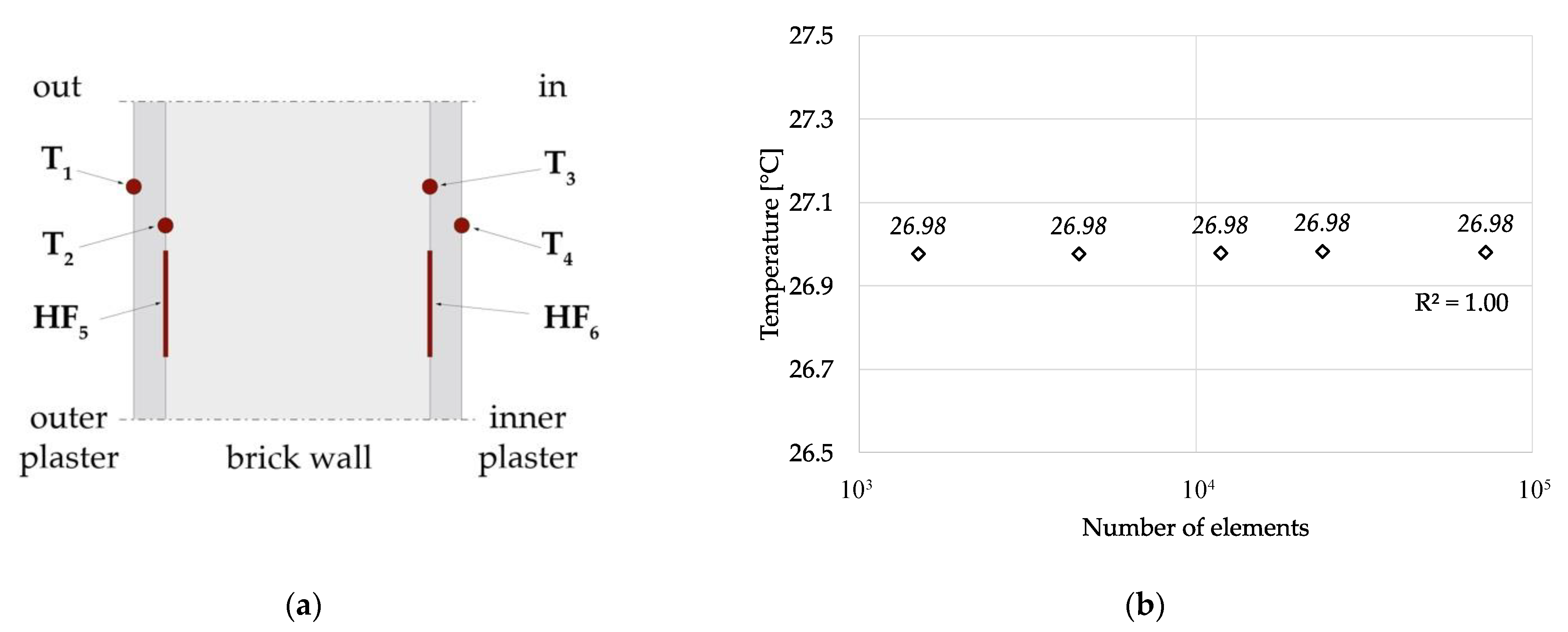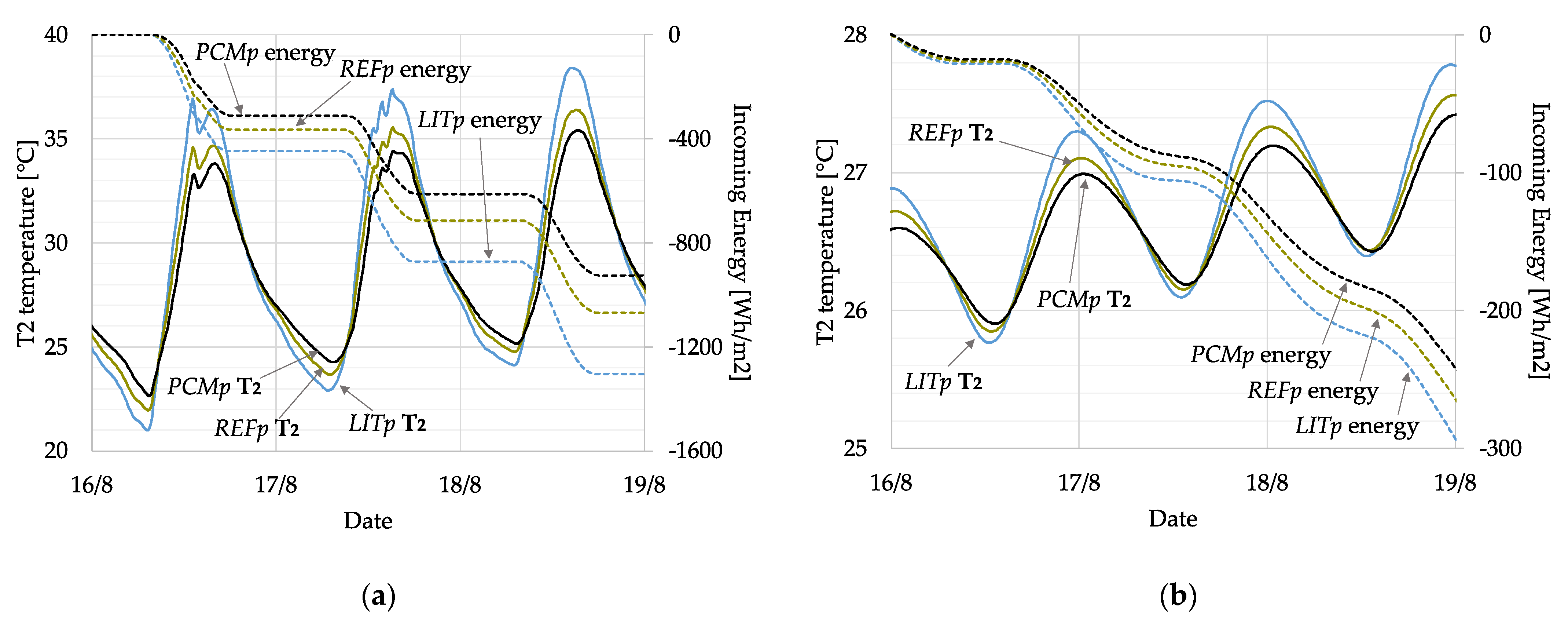Granular PCM-Enhanced Plaster for Historical Buildings: Experimental Tests and Numerical Studies
Abstract
:1. Introduction
2. Materials and Methods
2.1. Experimental Set Up
2.2. Thermal Properties Estimation
2.2.1. Thermal Conductivity
2.2.2. Specific Heat of the Masonry Tile
2.2.3. Specific Heat and PCM Latent Heat
2.2.4. Numerical Model of a Perimeter Wall
3. Results
3.1. Two-Brick-Thick Wall (25 cm)
3.2. Three-Brick-Thick Wall (38 cm)
4. Discussion
5. Conclusions
Author Contributions
Funding
Institutional Review Board Statement
Informed Consent Statement
Data Availability Statement
Acknowledgments
Conflicts of Interest
References
- Sinka, M.; Bajare, D.; Jakovics, A.; Ratnieks, J.; Gendelis, S.; Tihana, J. Experimental testing of phase change materials in a warm-summer humid continental climate. Energy Build. 2019, 195, 205–215. [Google Scholar] [CrossRef]
- Lizana, J.; Chacartegui, R.; Barrios-Padura, A.; Valverde, J.M. Advances in thermal energy storage materials and their applications towards zero energy buildings: A critical review. Appl. Energy 2017, 203, 219–239. [Google Scholar] [CrossRef]
- Asadi, E.; da Silva, M.G.; Antunes, C.H.; Dias, L. Multi-objective optimization for building retrofit strategies: A model and an application. Energy Build. 2012, 44, 81–87. [Google Scholar] [CrossRef]
- 2020 Global Status Report for Buildings and Construction. Available online: https://globalabc.org/resources/publications/2020-global-status-report-buildings-and-construction (accessed on 13 January 2021).
- Pavlík, Z.; Trník, A.; Keppert, M.; Pavlíková, M.; Žumár, J.; Černý, R. Experimental Investigation of the Properties of Lime-based Plaster-Containing PCM for Enhancing the Heat-Storage Capacity of Building Envelopes. Int. J. Thermophys. 2014, 35, 767–782. [Google Scholar] [CrossRef]
- Ürge-Vorsatz, D.; Cabeza, L.F.; Serrano, S.; Barreneche, C.; Petrichenko, K. Heating and cooling energy trends and drivers in buildings. Renew. Sustain. Energy Rev. 2015, 41, 85–98. [Google Scholar] [CrossRef] [Green Version]
- Pandey, B.; Banerjee, R.; Sharma, A. Coupled EnergyPlus and CFD analysis of PCM for thermal management of buildings. Energy Build. 2021, 231, 110598. [Google Scholar] [CrossRef]
- Dalla Mora, T.; Cappelletti, F.; Peron, F.; Romagnoni, P.; Bauman, F. Retrofit of an historical building toward NZEB. Energy Procedia 2015, 78, 1359–1364. [Google Scholar] [CrossRef] [Green Version]
- Eurostat. Census Hub HC53. Available online: https://ec.europa.eu/CensusHub2/query.do?step=selectHyperCube&qhc=false (accessed on 8 May 2020).
- Coppola, L.; Coffetti, D.; Lorenzi, S. Cement-Based Renders Manufactured with Phase-Change Materials: Applications and Feasibility. Adv. Mater. Sci. Eng. 2016, 2016, 7254823. [Google Scholar] [CrossRef] [Green Version]
- Rapporto Bes. Il Benessere Equo e Sostenibile in Italia. Available online: https://www.istat.it/it/files//2013/03/9_Paesaggio-e-patrimonio-cult.pdf (accessed on 8 September 2021).
- Bianco, L.; Serra, V.; Fantucci, S.; Dutto, M.; Massolino, M. Thermal insulating plaster as a solution for refurbishing historic building envelopes: First experimental results. Energy Build. 2015, 95, 86–91. [Google Scholar] [CrossRef]
- Wijesuriya, S.; Tabares-Velasco, P.C.; Biswas, K.; Heim, D. Empirical validation and comparison of PCM modeling algorithms commonly used in building energy and hygrothermal software. Build. Environ. 2020, 173, 106750. [Google Scholar] [CrossRef]
- Akeiber, H.; Nejat, P.; Majid, M.Z.A.; Wahid, M.A.; Jomehzadeh, F.; Famileh, I.Z.; Calautit, J.K.; Hughes, B.R.; Zaki, S.A. A review on phase change material (PCM) for sustainable passive cooling in building envelopes. Renew. Sustain. Energy Rev. 2016, 60, 1470–1497. [Google Scholar] [CrossRef]
- Sá, A.V.; Azenha, M.; de Sousa, H.; Samagaio, A. Thermal enhancement of plastering mortars with Phase Change Materials: Experimental and numerical approach. Energy Build. 2012, 49, 16–27. [Google Scholar] [CrossRef]
- Cabeza, L.F.; Castell, A.; Barreneche, C.; de Gracia, A.; Fernandez, A.I. Materials used as PCM in thermal energy storage in buildings: A review. Renew. Sustain. Energy Rev. 2011, 15, 1675–1695. [Google Scholar] [CrossRef]
- Lachheb, M.; Younsi, Z.; Naji, H.; Karkri, M.; Ben Nasrallah, S. Thermal behavior of a hybrid PCM/plaster: A numerical and experimental investigation. Appl. Therm. Eng. 2017, 111, 49–59. [Google Scholar] [CrossRef]
- Navarro, L.; de Gracia, A.; Castell, A.; Cabeza, L.F. Thermal behaviour of insulation and phase change materials in buildings with internal heat loads: Experimental study. Energy Effic. 2015, 8, 895–904. [Google Scholar] [CrossRef] [Green Version]
- Cunha, S.; Alves, V.; Aguiar, J.B.; Ferreira, V.M. Use of phase change materials microcapsules in aerial lime and gypsum mortars. Cem. Wapno Beton. 2011, 17–21. [Google Scholar]
- Sukontasukkul, P.; Sutthiphasilp, T.; Chalodhorn, W.; Chindaprasirt, P. Improving thermal properties of exterior plastering mortars with phase change materials with different melting temperatures: Paraffin and polyethylene glycol. Adv. Build. Energy Res. 2019, 13, 220–240. [Google Scholar] [CrossRef]
- Ventolà, L.; Vendrell, M.; Giraldez, P. Newly-designed traditional lime mortar with a phase change material as an additive. Constr. Build. Mater. 2013, 27, 1210–1216. [Google Scholar] [CrossRef]
- Pavlík, Z.; Fort, J.; Pavlíková, M.; Pokorny, J.; Trník, A.; Černý, R. Modified lime-cement plasters with enhanced thermal and hygric storage capacity for moderation of interior climate. Energy Build. 2016, 126, 113–127. [Google Scholar] [CrossRef]
- Kheradmand, M.; Aguiar, J.; Azenha, M. Assessment of the thermal performance of plastering mortars within controlled test cells. In Proceedings of the Congresso Luso-Brasileiro de Materiais de Construçao Sustentaveis, Guimarães, Portugal, 5–7 March 2014. [Google Scholar]
- Maleki, B.; Khadang, A.; Meddah, H.; Alizadeh, M.; Kazemian, A.; Ali, H.M. Development and thermal performance of nanoencapsulated PCM/plaster wallboard for thermal energy storage in buildings. J. Build. Eng. 2020, 32, 101727. [Google Scholar] [CrossRef]
- Paranjothi, G.; Odukomaiya, A.; Cui, S.; Bulk, A. Evaluation of phase change plaster/paste composites for building envelopes. Energy Build. 2021, 253, 111372. [Google Scholar] [CrossRef]
- Fort, J.; Trník, A.; Pavlíková, M.; Pavlík, Z.; Černý, R. Fabrication of dodecanol/diatomite shape-stabilized PCM and its utilization in interior plaster. Int. J. Thermophys. 2018, 39, 137. [Google Scholar] [CrossRef]
- Karaipekli, A.; Sari, A. Development and thermal performance of pumice/organic PCM/gypsum composite plasters for thermal energy storage in buildings. Sol. Energy Mater. Sol. Cells 2016, 149, 19–28. [Google Scholar] [CrossRef]
- Fort, J.; Pavlíková, M.; Trník, A.; Pavlík, Z. Thermal behaviour of new type of plaster with PCM admixture. Appl. Mech. Mater. 2015, 710, 3–7. [Google Scholar] [CrossRef]
- Soudian, S.; Berardi, U.; Laschuk, N. Development and thermal-optical characterization of a cementitious plaster with phase change materials and thermochromic paint. Sol. Energy 2020, 205, 282–291. [Google Scholar] [CrossRef]
- Theodoridou, M.; Kyriakou, L.; Ioannou, I. PCM-enhanced lime plaster for vernacular and contemporary architecture. Energy Procedia 2016, 97, 539–545. [Google Scholar] [CrossRef] [Green Version]
- Baccega, E.; Bottarelli, M. Numerical and experimental evaluation of a granular PCM-enhanced plaster for historic building application. In Proceedings of the International Building Performance Simulation Association 2021, Bruges, Belgium, 1–3 September 2021. in press. [Google Scholar]
- Moropoulou, A.; Bakolas, A.; Anagnstopoulou, S. Composite materials in ancient structures. Cem. Concr Compos. 2005, 27, 295–300. [Google Scholar] [CrossRef]
- Stefanidou, M.; Assael, M.; Antoniadis, K.; Matziaroglou, G. Thermal conductivity of building materials employed in the preservation of traditional structures. Int. J. Thermophys. 2010, 31, 844–851. [Google Scholar] [CrossRef]
- Cui, Y.; Xie, J.; Liu, J.; Wang, J.; Chen, S. A review on phase change material application in building. Adv. Mech. Eng. 2017, 9, 1–15. [Google Scholar] [CrossRef] [Green Version]
- Drissi, S.; Ling, T.-C.; Mo, K.H.; Eddhahak, A. A review of microencapsulated and composite phase change materials: Alteration of strength and thermal properties of cement-based materials. Renew. Sustain. Energy Rev. 2019, 110, 467–484. [Google Scholar] [CrossRef]
- COMSOL Multiphysics Reference Manual. Available online: http://www.comsol.com (accessed on 19 November 2020).
- Memmert CTC 256. Available online: https://www.memmert.com/products/climate-chambers/environmental-test-chambers/CTC256/ (accessed on 12 January 2021).
- Almemo Ahlborn. Available online: https://www.ahlborn.com/download/pdfs/kap01/eng/5690n-e.pdf (accessed on 8 September 2021).
- ISO/IEC GUIDE 98-3:2008.Uncerttainty of measurement. Part 3: Guide to the Expression of Uncertainty in Measurement (GUM:1995). Available online: https://webstore.iec.ch/publication/11961 (accessed on 12 January 2021).
- Fassa, S.r.l. Available online: https://www.fassabortolo.it/it/prodotti/-/p/6/62/ex-novo-restauro-storico/intonaco-700-bio-intonaco-di-fondo-a-base-di-calce-idraulica-naturale-nhl-3-5-per-interni-ed-esterni (accessed on 22 October 2020).
- PCM Products Ltd. Available online: https://www.pcmproducts.net (accessed on 12 January 2021).
- TESSe2b-Thermal Energy Storage Systems for Energy Efficient Buildings. Available online: http://www.tesse2b.eu/tesse2b/home (accessed on 12 January 2021).
- GWInstek. Available online: https://www.gwinstek.com/en-global/products/detail/PSW-Series (accessed on 12 January 2021).
- Li, C.; Yu, H.; Song, Y. Experimental investigation of thermal performance of microencapsulated PCM-contained wallboard by two measurement modes. Energy Build. 2019, 184, 34–43. [Google Scholar] [CrossRef]
- Černý, R.; Kunca, A.; Tydlitat, V.; Drchalova, J.; Rovnanikova, P. Effect of pozzolanic admixtures on mechanical, thermal and hygric properties of lime plasters. Constr. Build. Mater. 2006, 20, 849–857. [Google Scholar] [CrossRef]
- Walker, R.; Pavia, S. Thermal and hygric properties of insulation materials suitable for historic fabrics. In Proceedings of the III International Congress on Construction and Building Research, Madrid, Spain, 14–16 December 2015. [Google Scholar]
- Akkurt, G.C.; Aste, N.; Borderon, J.; Buda, A.; Calzolari, M.; Chung, D.; Costanzo, V.; Del Pero, C.; Evola, G.; Huerto-Cardenas, H.E.; et al. Dynamic thermal and hygrometric simulation of historical buildings: Critical factors and possible solutions. Renew. Sustain. Energy Rev. 2020, 118, 109509. [Google Scholar] [CrossRef]
- Franco, G.; Magrini, A. Historical Buildings and Energy, 1st ed.; Springer: Cham, Switzerland, 2018; p. 60. [Google Scholar]
- Jerman, M.; Vejmelikovà, E.; Keppert, M.; Černý, R. Properties of plasters suitable for reconstruction of historical buildings. In Structural Studies, Repairs and Maintenance of Heritage Architecture XIII, 1st ed.; Brebbia, C.A., Ed.; WIT Press: Southampton, UK, 2013; pp. 369–378. [Google Scholar]
- Lucchi, E. Thermal transmittance of historical brick masonries: A comparison among standard data, analytical calculation procedures, and in situ heat flow meter measurements. Energy Build. 2017, 134, 171–184. [Google Scholar] [CrossRef]
- Bottarelli, M.; Bortoloni, M.; Su, Y.; Yousinf, C.; Aydın, A.A.; Georgiev, A. Numerical analysis of a novel ground heat exchanger coupled with phase change materials. Appl. Therm. Eng. 2015, 88, 369–375. [Google Scholar] [CrossRef]
- Bottarelli, M.; Bortoloni, M.; Su, Y. Heat transfer of underground thermal energy storage in shallow trenches filled with encapsulated phase change materials. Appl. Therm. Eng. 2015, 90, 1044–1051. [Google Scholar] [CrossRef]
- Kheradmand, M.; Azenha, M.; Castro-Gomes, J.; Aguiar, J. Energy saving potential of cement based mortar containing hybrid phase change materials applied in building envelopes. In Proceedings of the Sustainable Construction Materials & Technologies 4, Las Vegas, NA, USA, 7–11 August 2016. [Google Scholar]
- Yao, J.; Yan, C. Effects of solar absorption coefficient of external walls on building energy consumption. Int. J. Civ. Environ. Struct. Constr. Archit. Eng. 2011, 4, 208–210. [Google Scholar]
- UNI EN ISO 6946:2018 (Italian version of EN ISO 6946:2017). Building Components and Building Elements. Thermal Resistance and Thermal Transmittance. Calculation Method. Available online: http://store.uni.com/catalogo/uni-en-iso-6946-2018?josso_back_to=http://store.uni.com/josso-security-check.php&josso_cmd=login_optional&josso_partnerapp_host=store.uni.com (accessed on 12 January 2021).













| Tair [°C] | ±0.02 |
| Tup [°C] | ±0.007 |
| Tmid [°C] | ±0.02 |
| Tdown [°C] | ±0.02 |
| HFmid [W/m2] | ±0.06 |
| HFdown [W/m2] | ±0.04 |
| ρ [kg/m3] | |
|---|---|
| Reference plaster (REFp) | 1517 |
| PCM plaster (PCMp) | 1278 |
| Masonry tile | 1607 |
| REFp | PCMp | ||||||||
|---|---|---|---|---|---|---|---|---|---|
| A | B | C | A | B | C | D | E | F | |
| Tair [°C] | 25.0 | 25.0 | 45.0 | ||||||
| Tup [°C] | 21.8 | 21.1 | 19.7 | 22.3 | 21.6 | 20.7 | 43.9 | 42.9 | 41.9 |
| Tmid [°C] | 16.8 | 15.0 | 11.0 | 16.4 | 14.4 | 10.6 | 41.5 | 38.0 | 34.8 |
| Tdown [°C] | 12.6 | 9.6 | 3.7 | 12.5 | 9.5 | 3.7 | 40.2 | 35.3 | 30.8 |
| [W/m2] | 76.1 | 95.4 | 131.0 | 72.3 | 89.5 | 120.1 | 27.1 | 55.6 | 81.8 |
| λplaster [W/(m·K)] | 0.31 ± 0.006 | 0.24 ± 0.005 | |||||||
| λmasonry tile [W/(m·K)] | 0.50 ± 0.016 | ||||||||
| h [W/(m2·K)] | 25.70 ± 0.003 | ||||||||
| ρ [kg/m3] | λ [W/(m·K)] | cp [J/(kg·K)] | |
|---|---|---|---|
| [28] | 1861 | 0.86 | - |
| [30] | 1680 | 0.94 | 887 |
| [45] | 1660 | 0.73 | 970 |
| [46] | 1820 | 0.80 | 863.9 |
| [47] | 1800 | 0.70 | - |
| [48] | 1800 | 0.90 | 840 |
| [49] | 1805 | 1.042 | 817 |
| ρ [kg/m3] | λ [W/(m·K)] | cp [J/(kg·K)] | |
|---|---|---|---|
| Masonry tile | 1607 | 0.50 | 800 |
| REFp | PCMp | |
|---|---|---|
| Tup [°C] | 0.28 | 0.41 |
| Tmid [°C] | 0.20 | 0.18 |
| HFmid [W/m2] | 2.26 | 2.18 |
| ρ [kg/m3] | λ [W/(m·K)] | cp [J/(kg·K)] | |
|---|---|---|---|
| Reference plaster (REFp) | 1517 | 0.31 | 800 |
| PCM plaster (PCMp) | 1278 | 0.24 | 930 |
| Literature plaster (LITp) | 1820 | 0.73 | 970 |
Publisher’s Note: MDPI stays neutral with regard to jurisdictional claims in published maps and institutional affiliations. |
© 2022 by the authors. Licensee MDPI, Basel, Switzerland. This article is an open access article distributed under the terms and conditions of the Creative Commons Attribution (CC BY) license (https://creativecommons.org/licenses/by/4.0/).
Share and Cite
Baccega, E.; Bottarelli, M. Granular PCM-Enhanced Plaster for Historical Buildings: Experimental Tests and Numerical Studies. Energies 2022, 15, 975. https://doi.org/10.3390/en15030975
Baccega E, Bottarelli M. Granular PCM-Enhanced Plaster for Historical Buildings: Experimental Tests and Numerical Studies. Energies. 2022; 15(3):975. https://doi.org/10.3390/en15030975
Chicago/Turabian StyleBaccega, Eleonora, and Michele Bottarelli. 2022. "Granular PCM-Enhanced Plaster for Historical Buildings: Experimental Tests and Numerical Studies" Energies 15, no. 3: 975. https://doi.org/10.3390/en15030975







